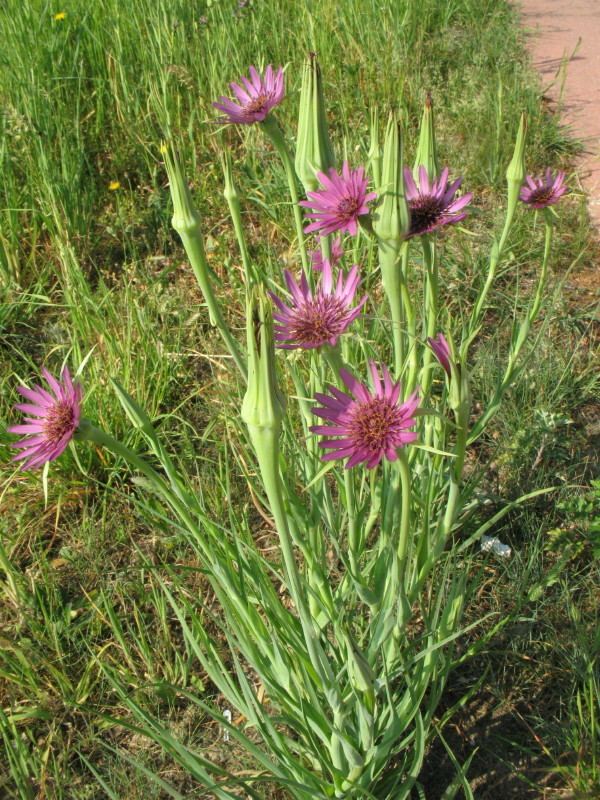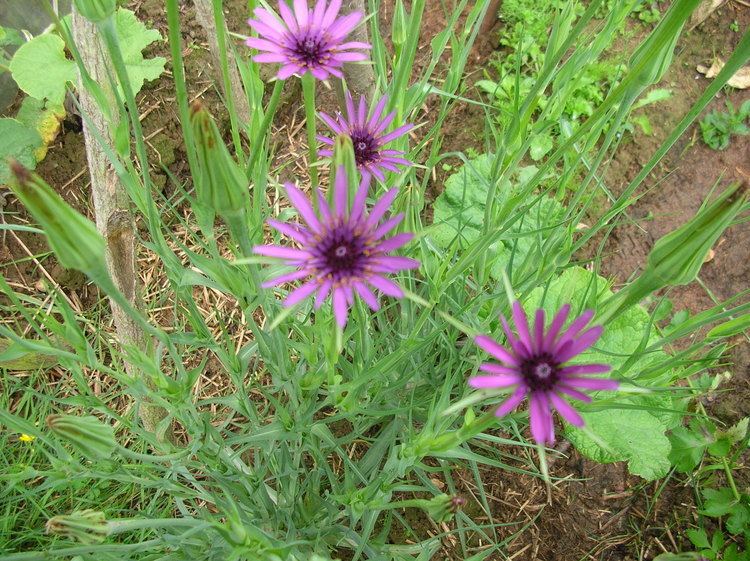Calcium 60 mg (per 100 g) Higher classification Salsify | Genus Tragopogon Protein 3.3 g (per 100 g) Rank Species | |
 | ||
Energy 81.98 Calories (per 100 g) Similar Salsify, Black salsify, Water, Parsnip, Celeriac | ||
Tragopogon porrifolius is a plant cultivated for its ornamental flower, edible root, and herbal properties. It also grows wild in many places and is one of the most widely known species of the salsify genus, Tragopogon. It is commonly known as purple or common salsify, oyster plant, vegetable oyster, Jerusalem star, goatsbeard or simply salsify (although these last two names are also applied to other species, as well).
Contents

Description

Tragopogon porrifolius is a common biennial wildflower, native to Mediterranean regions of Europe but introduced elsewhere, for example, into the British Isles (mainly in central and southern England), other parts of northern Europe, North America, and southern Africa and in Australia; in the United States it is now found growing wild in almost every state, including Hawaii, except in the extreme south-east.

The plant grows to around 120 cm in height. As with other Tragopogon species, its stem is largely unbranched, and the leaves are somewhat grasslike. It exudes a milky juice from the stems.

In the UK it flowers from June to September, but in warmer areas such as California it can be found in bloom from April. The flower head is about 5 cm across, and each is surrounded by green bracts which are longer than the petals (technically, the ligules of the ray flowers). The flowers are like that of Goatsbeard Tragopogon pratensis, but are larger and dull purple, 30-50mm across. The flowers are hermaphroditic, and pollination is by insects.
The fruits are achenes.
Cultivation and uses

The root, and sometimes the young shoots, of T. porrifolius are used as a vegetable, and historically the plant was cultivated for that purpose; it is mentioned by classical authors such as Pliny the Elder. Cultivation in Europe began in the 16th century in France and Italy. In the United Kingdom it was initially grown for its flower and later became a mildly popular vegetable in the 18th century but then declined in popularity. Presently the root is cultivated and eaten most frequently in France, Germany, Italy and Russia. However, in modern times it has tended to be replaced by Spanish salsify (Scorzonera hispanica) as a cultivated crop. Cultivated varieties include White French, Mammoth Sandwich Island, and Improved Mammoth Sandwich Island; they are generally characterised by larger or better-shaped roots. The root becomes discolored and spoils quickly if broken, which can easily happen since it is difficult to remove from the soil without damage. The root is noted for tasting of oysters, from which the plant derives its alternative name of oyster plant; young roots can be grated for use in salads, but older roots are better cooked, and they are usually used in soups or stews. It is recommended that when using the root that, if cut, its color be preserved in acidulated water. A latex derived from the root can be used as a chewing gum. The flowering shoots can be used like asparagus, either raw or cooked, and the flowers can be added to salad, while the sprouted seeds can be used in salads or sandwiches.
The plant has also been used in herbalism, also since classical times (it is mentioned by Dioscorides), and is claimed to have beneficial effects on the liver and gall bladder. The root is regarded as a diuretic.
Secondary metabolites
Tragopogon porrifolius bibenzyl derivatives and dihydroisocoumarin. Additionally, Tragopogon porrifolius yielded the first example of a naturally occurring dimeric dihydroisocoumarin. This compound named tragoponol features a twelve membered dilactone ring. Moreover, Tragopogon porrifolius yielded caffeic acid derivatives, a simple coumarin glycoside, and various C-glycosyl flavonoids.
